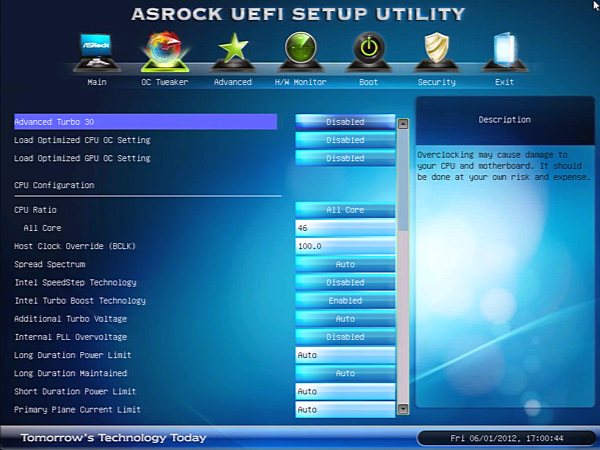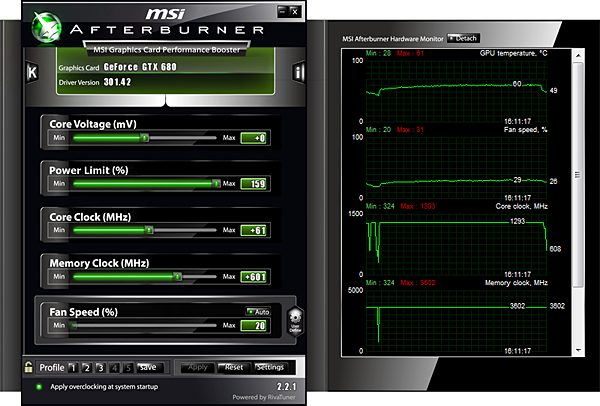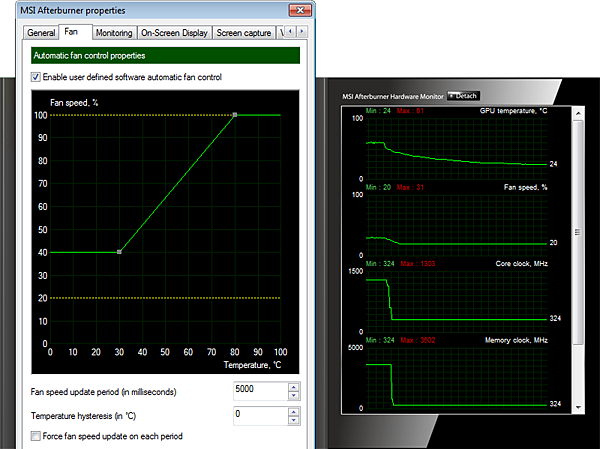System Builder Marathon, June 2012: $2000 Performance PC
Overclocking
In light of revelations concerning Intel’s Ivy Bridge heat spreader application, our strategy for this machine’s overclock would be to keep core voltage low, external cooling high, and hope for the best.
And then the best actually happened: we were able to reach 4.6 GHz with minimal fuss.
We did face a fairly difficult heat transfer issue, limiting our voltage tolerance to 1.25 V. Though 4.7 GHz would have been possible at 1.28 V, the added heat caused the Core i7-3770K to throttle during our combined load (CPU and GPU) tests.
We were able to push our DDR3-1600 CAS 8 kit to DDR3-2000 CAS 8 after making minor alterations to its tRCD and tRP. We tested various tRAS values between 16 and 24 cycles and, finding no performance difference, thought the lower number looked better.
This Asus graphics card comes with an extremely nice and well-detailed overclocking utility, exceeding the adjustability of MSI’s universal Afterburner utility. Unfortunately, Asus' software didn’t make the card overclock any higher, and we couldn’t find temperature-based fan controls. Not willing to tolerate a high noise level from an idle card, we made the switch.
The GeForce GTX 680 uses GPU Boost to increase frame rates when the headroom provides for it, scaling back under more thermally-taxing workloads. Increasing the card’s power limit also increases its ability to hold boost frequency, though simultaneously increasing the likelihood that the GPU will encounter instability.
Given the option of a higher frequency that doesn’t hold up well or a moderate frequency that’s usually there when needed, this editor chose the latter. The card’s Power Limit was set to maximum, which reduced its GPU overclock to a mere 61 MHz over Asus’ already-high 1201 MHz boost frequency.
The graphics RAM overclock was far more interesting, jumping from GDDR5-6008 to an incredible GDDR5-7204. Thanks Asus!
Our overclock did require a little fuss over fan settings. MSI Afterburner provides a custom fan profile setting that can be arranged to anything from a straight line to a fancy multi-point curve. We used a standard slope, allowing the card to be quiet at low loads and noticeably loud after extended periods at full load.
Get Tom's Hardware's best news and in-depth reviews, straight to your inbox.
-
vakuma5000 Awesome Build!!Reply
I have the exact same GTX 680 from ASUS, and I love it. Managed to get 1337Mhz out of the core and 6800 out of the memory. I achieved that with only 115% power limit. If I raise the power limit any higher, i start to loose performance and stability. That is a truly awesome memory oveerclock you got out of it! Congrats!
Very much looking foreward to the value comparison.
Would LOVE to see the 1800$ build win the value comparo!
GO GTX 680!!
My vote goes towards keeping a gaming focus as opposed to a more "all-in-one" type build.
Love the System Builder Articles, love Toms! -
vakuma5000 Unfortunately GTX 680 availability is still pretty spotty.Reply
Had to spend 2 days on newegg, refreshing the page every few mins to get the model i wanted.
However, it IS looking better. They are listing them more often on newegg, and they don't sell-out as quickly as they were a few weeks ago.
Check newegg daily from 5:30pm to 6:30 pm CST, and you should be able to catch one.
The GTX 670's are in stock right now.
Good luck rohitbaran! -
slicedtoad Replyshould we keep the gaming focus or move back towards higher-cost do-it-all machines?
Personally, I'm happy with the gaming focus. Don't know how others feel but gaming performance is more important than productivity benchmarks for me. I compile a lot of code and do some video encoding but I find gaining fps in games is more important than shaving seconds off my work. Besides, productivity follows gaming performance close enough.
On another note, I dislike value comparisons when things like SSD size and optical drives have made an impact in price. A larger SSD does nothing for a benchmark but is awesome in practice. I'd prefer only comparing the combined price of the gpu, cpu, cooler(s) and mobo in the value chart. That's not a perfect solution but it annoys me that things like high quality PSUs, nice cases, blu-ray burners and large SSDs throw things off so much. -
Crashman strandiamSo many great cases to choose from with so many great features....Perhaps the award-winning NZXT Phantom 410 next time?Reply
http://www.tomshardware.com/reviews/mana-136-midgard-ii-phantom-410,3203-5.html -
sam_fisher CrashmanPerhaps the award-winning NZXT Phantom 410 next time?http://www.tomshardware.com/review 203-5.htmlReply
My only dislike about this build is the case, for a $2000 PC I would prefer a case that was tidier and larger than the Antec Nine Hundred (especially with the layout of the HDD bays). The NZXT Phantom 410 would be much better for that budget.






